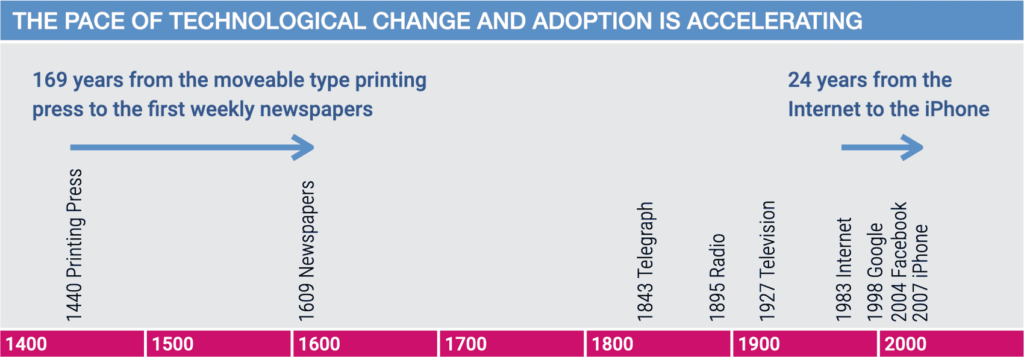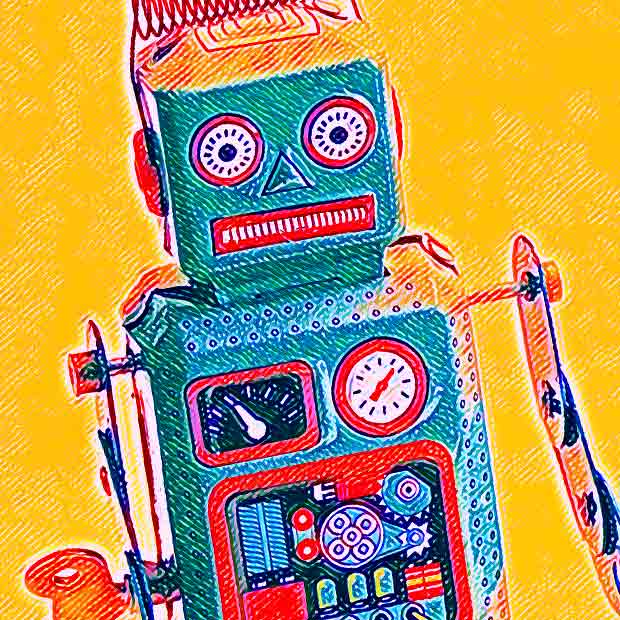There has been a lot of talk about artificial intelligence (AI) the last few years. Will this year be the tipping point when AI starts making a serious impact on how marketing communications content is created? A lot of creative people disdain the idea believing that machine-created copy, illustrations, photos, videos, voice and music can never compete on a serious level with human-created content.
As much as I share that sentiment, it reminds me of a time, back in the analog days before we created with computers, everything was made by hand. Layouts were drawn with markers and Rapidograph pens. Photos and motion pictures were shot on film and processed in darkrooms. Retouching was done with actual airbrushes. Personal computers, digital transformation and the internet changed all that. As it was happening, some people lamented the change from talented humans creating art by hand to anyone with a PC being able to make “art” where craft once prevailed. Others embraced the new tools—was there really a choice?

Technological advancement is inevitable. And as this illustration shows, the pace of change and the rate of technology adoption are accelerating. Artificial intelligence is the next frontier. If you think it will take 5-10 years to make a serious impact, in my opinion you should cut that timeline to 1-2 years.
AI seems different, doesn’t it? More than just a new set of tools, it’s like a new set of tools and an army of robots operating the tools for you. Since we all know it’s coming—whether we like the idea or not—I recommend you try it for yourself. Here are samples of content created with a range of free online AI tools. There are many many more out there. If you have used others, please share them in the comments box at the end of this post.
AI Generated voice
Text-to-voice is probably unremarkable to many of you, since your Mac, PC or phone can speak text to you using built-in accessibility features. Nonetheless, it’s a good example of how AI can be used to generate content. I’ve used Speechelo for voice-over narrations for videos, especially for scratch-tracks to put together rough edits before a human voice-over artist is paid for their talents. Try it!
PLAY AI-generated voice
Text to image
Want AI to create a photo or illustration for you by simply typing a text description? There are many AI tools available. The images below were made with Lexica. Are they great? No, not even close—at least not yet. But the fact that you can do it at all is a little amazing, isn’t it? How long until really good AI images will be as easy as typing text in a box?
Text to video
Using Synthesia, I simply selected a template, typed in a short script and poof, this video was created for me. It’s cheesy. But how long until text-generated videos are really good?
AI copy Writing
You can hardly turn around without seeing an article or news story about ChatGPT. If you haven’t tried it, you should. I used ChatGPT to write the next couple paragraphs. Here it is with no editing on my part:
It’s difficult to say exactly when AI will be able to fully replace humans for creating marketing communications content, as it depends on many factors including the advancement of AI technology, the development of sophisticated natural language generation algorithms, and the availability of large amounts of high-quality training data. However, it’s possible that AI could be used to assist humans in creating marketing communications content in the near future. Some companies are already using AI-powered tools to generate written content such as product descriptions, social media posts, and email marketing campaigns.
It’s also important to note that AI may be used to enhance some aspects of creating content, but it is unlikely to fully replace the creativity and human perspective that a human can bring to the process, this is especially important when it comes to developing a brand and creating campaigns that create emotional connections with consumers, as emotional connections and creativity are something difficult to replicate by AI.
Is it comforting that the leading AI copywriter thinks that humans are still necessary? Or is ChatGPT just humoring us?
The hue and cry
There’s an uproar from teachers concerned about students using AI to write papers. Artists are rightly concerned about AI appropriating their copyrighted work to be used as component elements in AI-generated photos or illustrations. These and similar concerns are all legitimate and may take years to resolve. If nothing else, it will be fascinating to see how it plays out.
Personally, my greatest concern is not so much marketing-communications content applications. Rather, I’m concerned about fake news. AI can already create believable deepfake video of people (living or dead) that can be foisted undetected on unsuspecting audiences—especially via social media. Then what? Check out this video of former President Richard Nixon announcing a moon landing disaster never actually happened, created by MIT.
In summary
I’ll be the first to admit that the examples in this post of content “created” using artificial intelligence tools are not all that great. Human-made content is still far superior. But it is pretty amazing that so many free or low-cost AI tools exist, allowing the creation of written content, images, video, audio, music, computer code and more with just a few keystrokes. How long until AI tools are ready for prime time? It’s still unclear. But one thing is for sure: it’s coming—and probably sooner than we might think.



I agree with your concerns about deepfakes used in news.
As extreme elements of our political spectrum tend to rely heavily on unverified news sources for information, could this technology potentially lead to more instances like the January 6th insurrection? While that event was not instigated by deepfake tech, it does show how a misinformed (disinformed?) group can be motivated to believe complete untruths and act on those beliefs to do real harm.
As we deal with our not-so-smart speakers and often comically incompetent digital assistants on a daily basis, we might be lulled into believing AI interference in our world order is decades away.
But is it? Or, as you suggested, could AI be humoring us?
Indeed. It’s not hard to imagine people on either end of the spectrum using AI to create deepfakes to promote their agenda to an unsuspecting public. Let’s hope that there are more and more tools that come into play similar to GPTZero to help prevent people from being duped. But then that would also require people to take time to be discerning—not something it great supply in a world dominated by social media. Thanks for your comments, Gary.
I think a really good application of ChatGPT right now is around SEO and content strategies. The tool can very quickly give you keyword lists (that need to be verified against AHREFS but they’re not bad), and then take those and turn them into a whole bunch of topics, and then dive deeper into those to get semantically related article titles. From there you could create some outlines for your copywriter to follow for the chosen articles, and then let them take over. Saves hours potentially in topic ideation. I think part of the reason this works well is because we do SEO content for a machine/Google anyway… so a machine is pretty good at helping us create good content for it. All that said… we’re about to see SEO completely change anyway once these AIs are a part of search. I don’t think we’ll be writing based on keywords in the same way.
Also seeing ChatGPT work really well as a coding assistant… it can generate quick snippets of code that generally work correctly really easily from a natural prompt, so that’s cool.
I think there’s applications in curriculum creation/education with these tools too… like you could use Lexica to generate an astronaut’s face and then use something like https://www.d-id.com/ and https://play.ht/ (much more natural voiceover) to create more engaging explainer videos for kids about space topics for instance. Here’s an example of a video I made that’s more in that education vein that’s a bit less goofy than your example (still issues through – the voices changes halfway through and the floating head is a little creepy): https://studio.d-id.com/share?id=a5246ed34d09670378526f53a6f6df91&utm_source=copy
Where I’m at now is just trying to learn as much as possible… I think we are rapidly moving toward people + AI far outperforming just people working without it. I’ve already started telling my students there’s a very high chance when they get out of college their job is going to revolve around using these tools in some way.
Insightful thoughts, good examples – thanks for your feedback!